Guide on the Mechanical Engineer ANZSCO Code: 233512
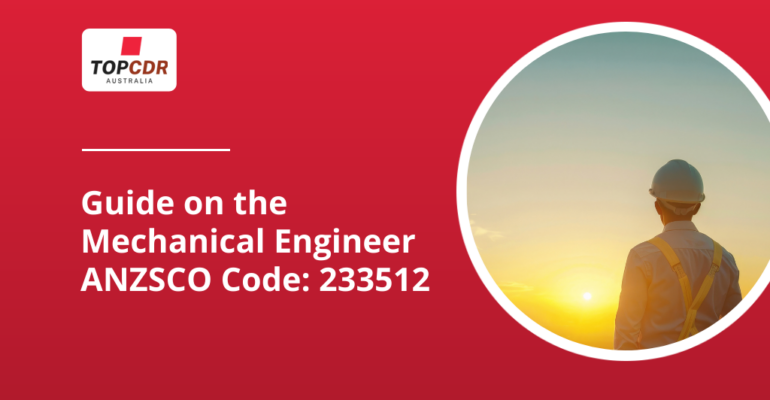
Guide on the Mechanical Engineer ANZSCO Code: 233512
Australia attracts many skilled professionals, and mechanical engineers are one of its most needed occupational groups. The expansion of manufacturing, construction, mining, and renewable energy industries drives rising employment requirements for qualified mechanical engineers.
To become an Australian immigrant as a mechanical engineer, you must understand ANZSCO Code: 233512. This complete guide contains all necessary information about the Mechanical Engineer ANZSCO Code: 233512.
It outlines job descriptions, responsibilities, required skills, migration requirements, visa possibilities, and Australian employment opportunities.
🔑 Key Highlights
- Mineral industries, together with power plants along construction companies, actively seek Mechanical Engineers for their operations.
- ANZSCO 233512 – Covers system design, machinery analysis, and safety standards.
- Migration Pathways – Requires skills assessment via Engineers Australia (CDR or accredited degree).
- PR Options – Eligible for skilled visas (189, 190, 491) and employer sponsorship.
Who is a mechanical engineer?
A mechanical engineer is a person who performs duties to create and examine, as well as develop and preserve, mechanical devices and product components.
Mechanical engineers provide critical expertise to production facilities, along with automobile industries, energy production operations, and mines, as well as constructing buildings and civil infrastructure.
Primary Responsibilities
Mechanical engineers perform several duties through their work responsibilities.
- The focus of their work includes designing and developing mechanical systems together with their process analysis.
- Technological research exists to enhance manufacturing procedures, together with increasing equipment operational efficiency.
- Engineers lead the process of overseeing machine setup as well as their usage for regular maintenance tasks and system troubleshooting.
- They investigate mechanical breakdowns to solve operational defects.
- The engineer must follow Australian engineering regulations and safety standards.
- The work requires team collaboration with electrical engineers and civil engineers as part of the team.
- The engineer uses design and simulation software, including AutoCAD, SolidWorks, MATLAB, and ANSYS, for their work.
- The evaluation of materials as well as production methods helps to improve both performance results with reduced environmental impact.
Educational Requirements for Mechanical Engineers in Australia 👨🎓
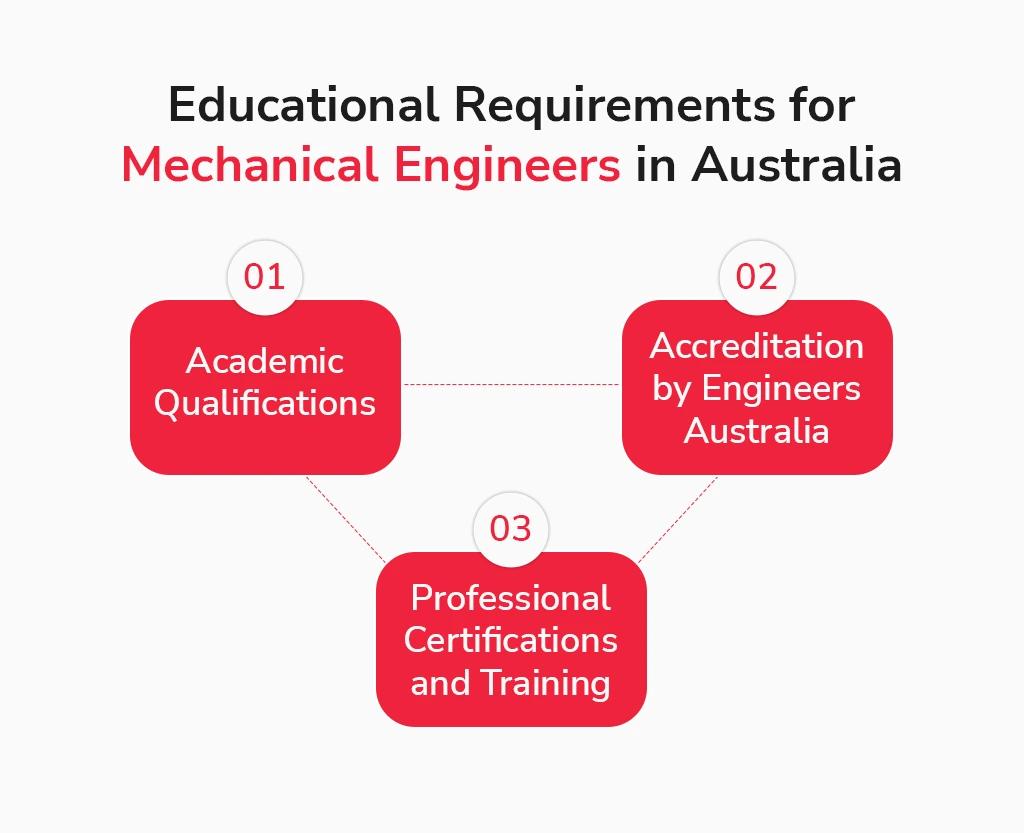
a. Academic Qualifications
An Australian mechanical engineer needs to graduate from an undergraduate Mechanical Engineering programme or an identical related field. Many engineers decide to pursue graduate studies to receive Master’s or doctorate degrees so they can specialise in areas such as thermodynamics, robotics, and mechatronics.
b. Accreditation by Engineers Australia
The official accreditation agency for engineers in Australia functions under Engineers Australia. To obtain work authorisation as an engineer in Australia, international professionals need Engineers Australia to complete an assessment of their credentials through the Migration Skills Assessment (MSA) process.
c. Professional Certifications and Training
Acquiring certifications in project management along with Six Sigma as well as CAD software training and automation skills creates additional opportunities in your career, but are optional for practitioners.
Skills Required for a Successful Career as a Mechanical Engineer
To thrive in this field, a mechanical engineer needs both technical expertise and social capabilities that include:
Technical Skills
- Computer-Aided Design: Ability in software like AutoCAD, SolidWorks, and CATIA.
- Finite Element Analysis: Understanding of stress analysis and simulations.
- The design of HVAC systems turbines alongside engines depends on the fundamental knowledge of thermodynamics and fluid mechanics.
- A mechanical engineer needs Material Science knowledge to understand engineering materials and their properties when selecting materials.
- Professional capability in project management includes handling engineering tasks through their lifecycle up to final delivery.
- Those who work in manufacturing must have expertise in CNC machining along with 3D printing and automation systems.
Soft Skills
- Mechanical problem-fixing abilities alongside effective solution development competencies.
- People who can work with multiple departments must illustrate skilled communication abilities while presenting technical material effectively.
- The ability to examine complicated engineering problems enables one to enhance design optimisation.
- Designers and manufacturers must maintain precise attention throughout the entire progression from design to production of mechanical components.
- The ability to maintain technological progress and the industry fleet with industry trends.
Why is there a high demand for mechanical engineers in Australia? 🤷
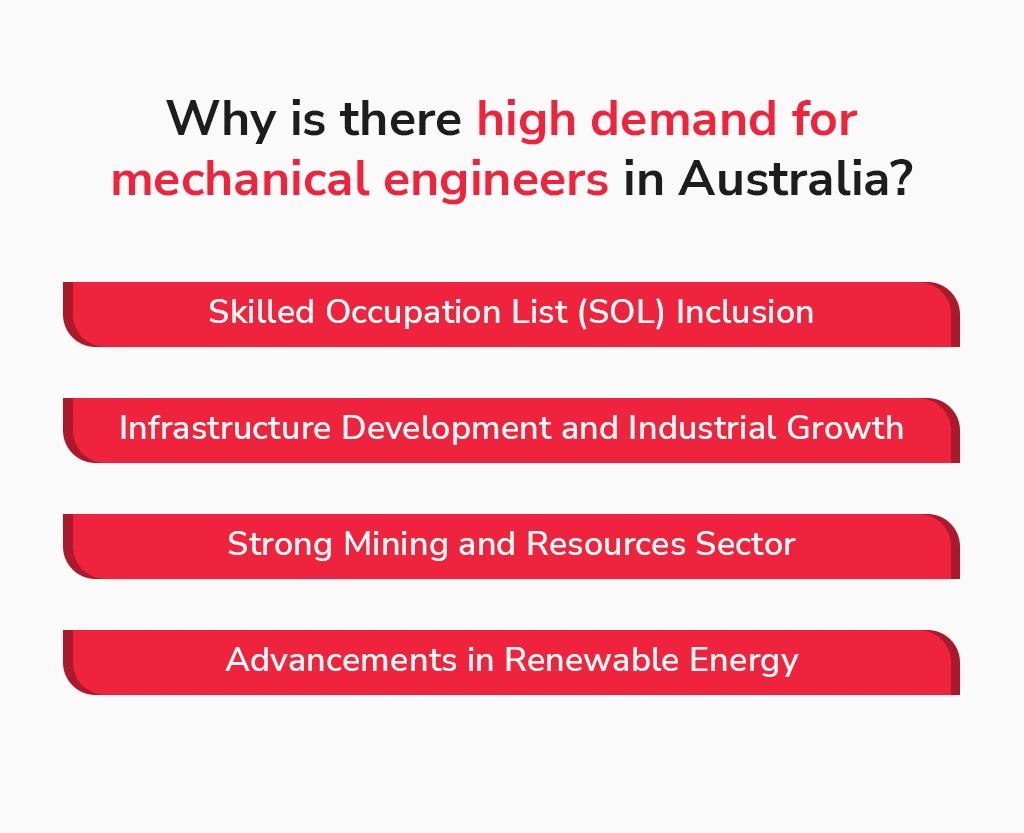
The demand for mechanical engineers holding code 233512 in Australia is rising for several reasons:
a. Skilled Occupation List (SOL) Inclusion
The SOL and the Medium and Long-Term Strategic Skills List of Australia include Mechanical Engineering because it is listed as an occupation.
Mechanical engineers from abroad can secure Australian work visas through the General Skilled Migration (GSM) programme according to the current requirements of the SOL.
b. Infrastructure Development and Industrial Growth
The country of Australia maintains large-scale infrastructure construction of transportation systems, bridges, and water facilities together with urban construction projects.
Government investment in billions of dollars for public infrastructure demands mechanical engineers to create designs, perform maintenance duties, and perform innovation tasks.
c. Strong Mining and Resources Sector
Australia takes a position as one of the top global producers of iron ore and coal, with added resources in gold production and the natural gas industry.
Mining companies need mechanical engineers to develop, sustain, and fix all types of machinery they utilise for mining extraction, along with transportation.
The mining industries of Western Australia (WA) and Queensland (QLD) lead to significant mechanical engineering labour requirements in this region.
d. Advancements in Renewable Energy
Sun-based energy, along with water power and wind-based power projects, receive substantial investment from Australia’s national government.
The rise of sustainability requires mechanical engineers to create and sustain wind turbines and solar panels together with energy-efficient systems.
The Australian national goal for net-zero emissions by 2050 creates a sustained market demand for mechanical engineers who focus on green energy solutions.
Key Industries Employing Mechanical Engineers in Australia
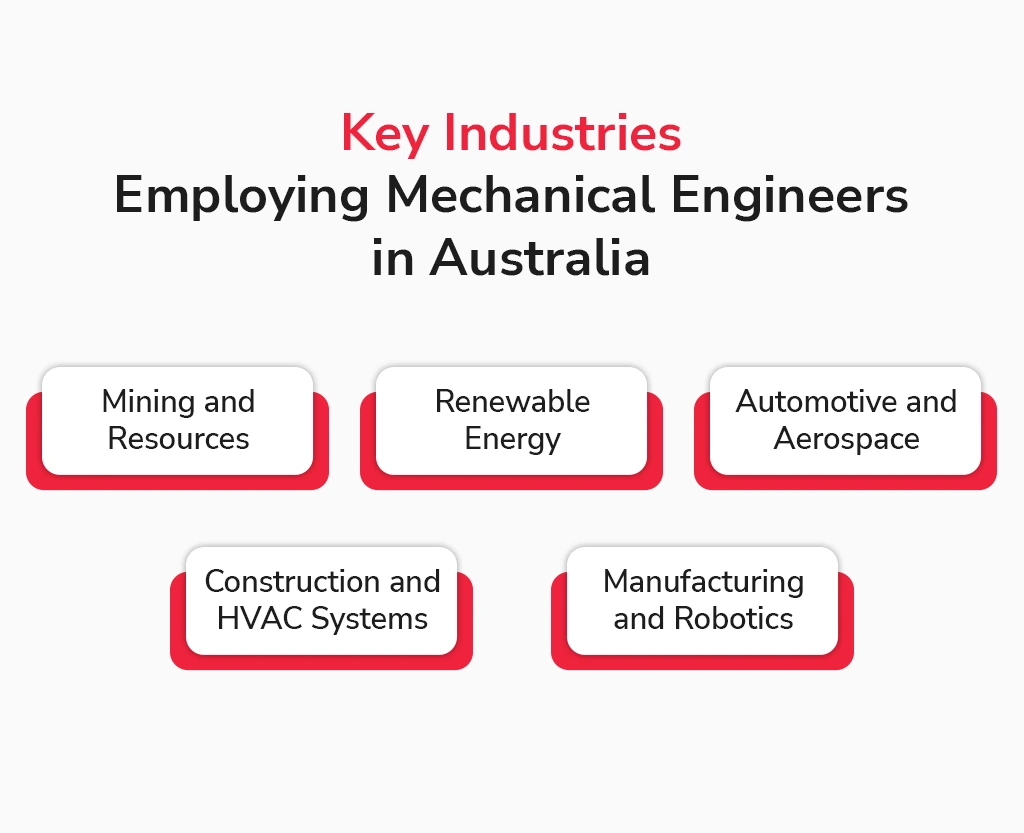
a. Mining and Resources
The main workplace of mechanical engineers lies inside mines, where they operate process plants, drilling facilities, and heavy machinery.
Major employers: BHP, Rio Tinto, Fortescue Metals Group, Newcrest Mining
b. Renewable Energy
Professionals in this field create wind power machines and solar energy networks with hydroelectric power facilities to support Australia’s renewable energy initiatives.
Major employers: Siemens, Vestas, Tesla, AGL Energy, Origin Energy
c. Automotive and Aerospace
Within this field, engineers create vehicles, aerodynamic systems, and propulsion systems in addition to designing maintenance procedures.
The Australian Defence Department, together with Boeing and Lockheed Martin, needs mechanical engineers to develop and improve advanced military aircraft designs.
Biggest employers: Boeing Australia, Airbus, Ford Australia, Tesla
d. Construction and HVAC Systems
Engineers design HVAC systems to meet the needs of building construction, along with factory facilities and tunnel systems.
The rising value of sustainable building construction in Australia generates a strong demand for energy-efficient HVAC systems in the market.
Major employers: AECOM, Arup, Laing O’Rourke, Lendlease
e. Manufacturing and Robotics
Australia poses an intelligent manufacturing model employing robotics together with automation and additive manufacturing technology known as 3D printing.
Professional engineers create automated production lines and industrial robots as well as CNC machine systems.
Major employers: CSIRO, Bosch Australia, ABB, Thales, BAE Systems
Migration Pathways for Mechanical Engineers in Australia
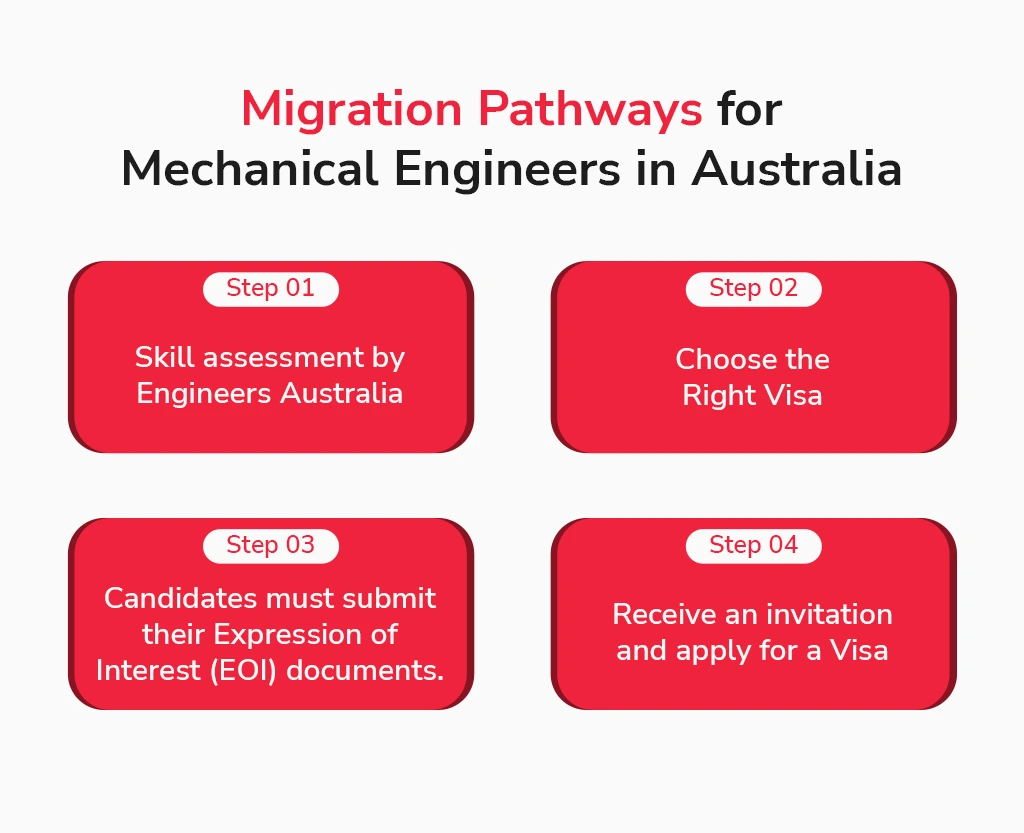
The process of migrating to Australia as a mechanical engineer includes both skills assessments and visa applications.
Step 1: Skill assessment by Engineers Australia
All professionals who aim to migrate to Australia need to complete their skills assessment process through Engineers Australia (EA). The evaluation confirms that applicants have credentials that match Australian professional requirements.
Pathways for Skills Assessment
- Accredited Qualifications Pathway
- How to Apply for Engineers Who Hold Bachelor Degrees Accredited By the Washington Accord.
- Almost all educational institutions in Australia and Canada, along with the United States and the United Kingdom, fulfil the requirements for qualification.
- Competency Demonstration Report (CDR) Pathway
- The assessment process accepts candidates holding non-accredited engineering qualifications.
- Engineers need to provide a CDR report that includes three career episodes about their engineering work and a summary statement connecting professional abilities to job code ANZSCO 233512 and continued professional development information.
- The application requires summaries describing engineering professional experience.
- The Summary Statement demonstrates how ANZSCO 233512 competencies match up.
- CPD (Continuing Professional Development) Report.
Step 2: Choose the Right Visa
The General Skilled Migration (GSM) Programme enables mechanical engineers to select from various skilled migration visas for Australian residency.
Popular Visa Options:
Applicants seeking the Skilled Independent Visa (Subclass 189) must pass a points system despite lacking employment sponsorships.
- Skilled Nominated Visa (Subclass 190): Requires nomination by an Australian state or territory.
- Skilled Work Regional Visa (Subclass 491) stands especially for qualified professionals who decide to work in Australian regional areas.
- Employer-Sponsored Visa (Subclass 482 & 186) a job offer from an Australian employer.
Step 3: Candidates must submit their Expression of Interest (EOI) documents.
Candidates need to get a positive skills assessment before submitting an Expression of Interest (EOI) through SkillSelect.
Step 4: Receive an invitation and apply for a Visa
Those with high points scores in SkillSelect get invitations that enable them to apply for the visa. The visa application process begins after receiving an invitation from SkillSelect, where candidates must provide the required documents as evidence.
Future Trends in Mechanical Engineering
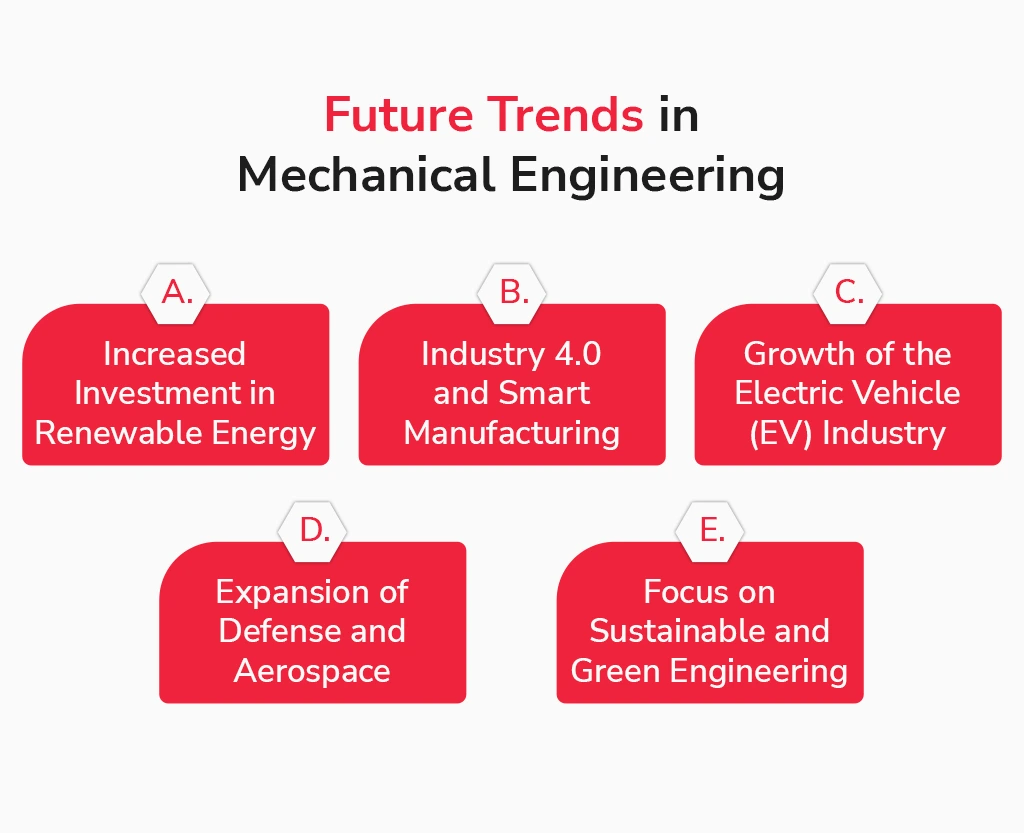
The Australian mechanical engineering industry predicts steady growth because businesses need new technological solutions.
a. Increased Investment in Renewable Energy
The energy sector requires further professionals for all aspects of wind generation and solar and hydrogen energy, as well as battery storage technologies.
b. Industry 4.0 and Smart Manufacturing
Engineering companies seek graduates who specialise in automation, AI, IoT (Internet of Things) and robotics technology.
c. Growth of the Electric Vehicle (EV) Industry
More employment opportunities will emerge across electric motor and sustainable transportation fields and EV battery design sectors.
d. Expansion of Defense and Aerospace
Australia advances its military technology development as well as space exploration and establishes new positions requiring mechanical engineering professionals.
e. Focus on Sustainable and Green Engineering
Engineers who focus on green materials, as well as carbon emission-free alternatives and smart city infrastructure development, will be needed most.
Conclusion
Australia’s economy relies on mechanical engineers, who show substantial employment market demand according to ANZSCO 233512. The ANZSCO Code 233512 serves as your foundation to get Australian work opportunities through either skilled visas or employer sponsorships.
When becoming a mechanical engineer migrant, you need to fulfil educational standards while obtaining approval from Engineers Australia and selecting suitable visa options.
The right qualifications combined with a proper approach will enable you to establish success as an engineer in Australia.
FAQs
1. What is the role of a 233512 mechanical engineer?
As a Mechanical Engineer, ANZSCO 233512 professionals design mechanical systems and analyse machinery to develop components while maintaining systems for various industries.
2. Is mechanical engineering on the PR list in Australia?
Yes, mechanical engineering is on Australia’s Skilled Occupation List, particularly under the Medium and Long-Term Strategic Skills List (MLTSSL).
3. What is the NOC code for a mechanical engineer?
The National Occupational Classification code for a mechanical engineer is 2132.
4. What is the duty of a mechanical engineer?
- Designing and Developing Systems
- Analysis and Testing
- Material Selection
- Project Management
- Troubleshooting and Maintenance
- Research and Innovation
- Collaboration
5. Which software is best for mechanical engineering?
Some of the best software for mechanical engineering is as follows:
- AutoCAD
- SolidWorks
- CATIA
- MATLAB
- CATIA

 Chat with us
Chat with us